This post contains affiliate links, meaning that if you make a purchase through one of my links I'll get a small commission at no cost to you.
I started writing this post prior to my recent glacier hiking trip to the Alps whilst I was packing, and I’m so glad that I didn’t finish it as I got my packing COMPLETELY WRONG. I packed far too much, missed off a couple of essential items and made my bag too heavy for lugging up mountains.
The trip that I’m talking about was the Italian High Level Route with KE Adventure Travel, which is essentially a version of the Spaghetti Tour. The route crosses the Swiss-Italian border in the Monte Rosa mountain massif and includes its fair share of glacier travel, 4000m peaks and mountain hut accommodation (which you can read more about here). I’d done other multi-day hikes before, but this was my first experience of glacier travel and my first purely hut-to-hut trek where I’d have no access to other luggage throughout the trip. This added a whole level of complexity to the packing list.

When booking with KE you’re given a packing list, but I like to put my own creative spin on it. However, when arriving in Zermatt and speaking to our highly experienced guide I realised that I was way off. Whether you’re off on this trip or any other glacier hiking trip in the alps, here’s what you need to be packing.
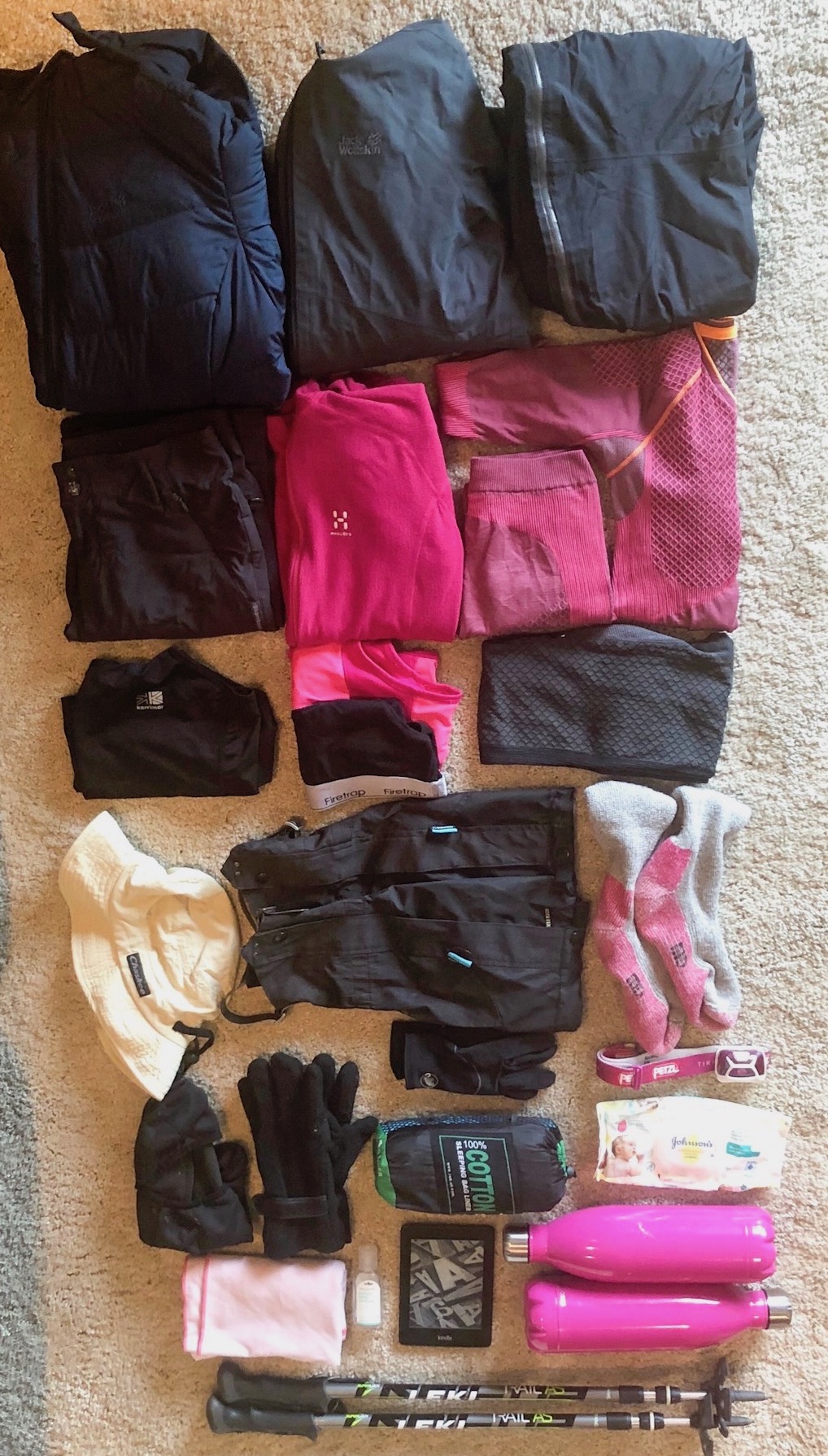
Boots
You’ll need boots suitable for use with crampons, so these should be a category B1 or B2 boot. The good news is that you can get some very pretty ones, the bad news is that they are pricey. As I’d not done this type of trek before I had to purchase some new boots, and went for the Scarpa Mantra GX Pro. For a boot that isn’t at all designed to be comfortable, these were actually pretty cosy and miraculously I didn’t get a single blister, although I did need to buy two sizes bigger than my usual shoe size to make space for extra thick socks.
Rucksack
I took my Osprey Aura Anti-Gravity rucksack, which I’ve talked about in My Slightly Girlie Guide to Hiking Kit Essentials. It was probably a little larger than what I needed, and the frame is quite long which meant that when climbing vertically I couldn’t tip my head back. However, the rest of the time it was oh so comfortable and I love that it’s completely adjustable.
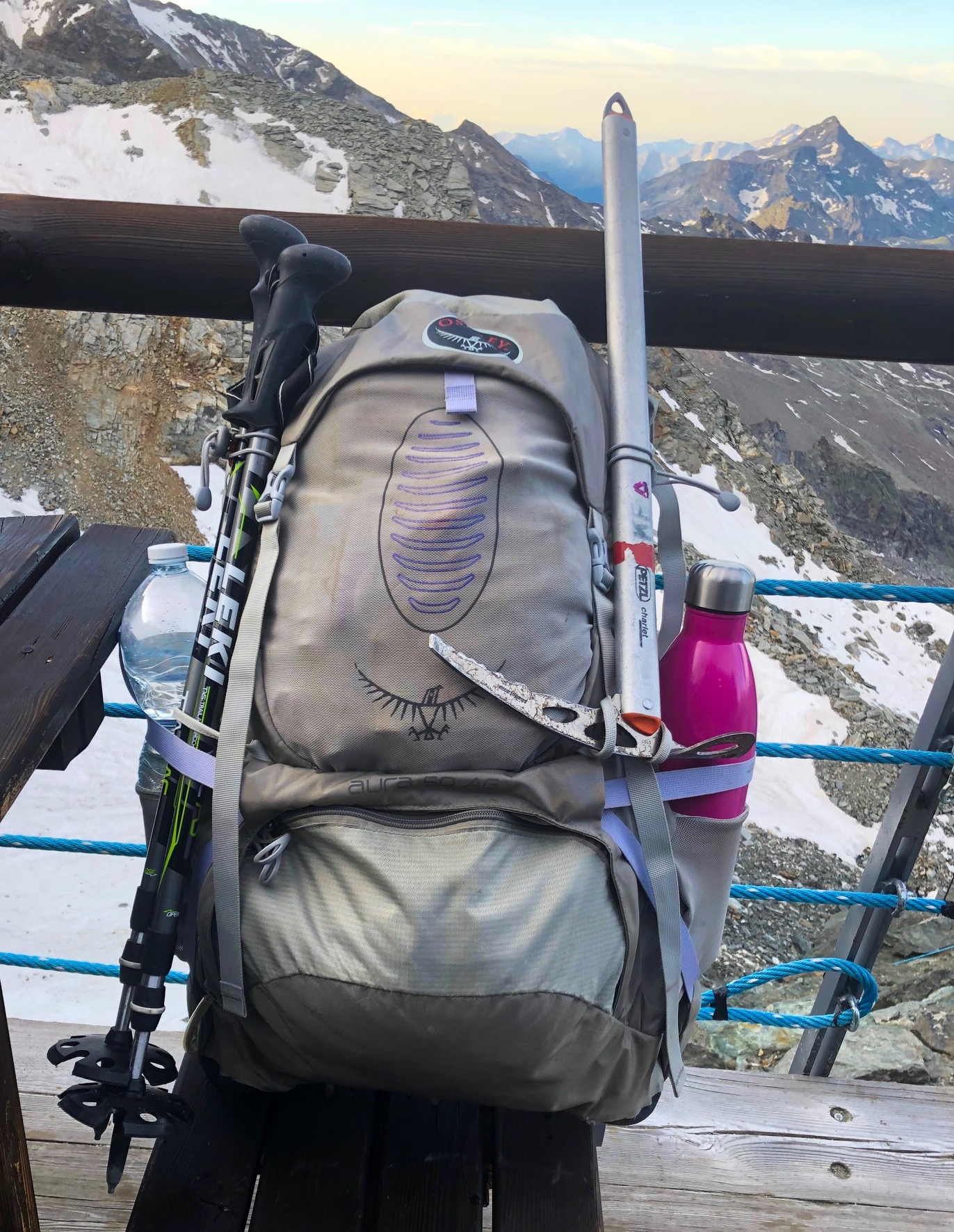
Trekking Poles (With Baskets)
I wouldn’t dream of hiking without trekking poles (you can read why here) and they were even more useful in the snow! Mine collapse quickly which meant it was easy to switch between trekking poles and an ice axe when needed. You’ll also need baskets to sit on the bottom of your poles to stop them from sinking into the snow.
Crampons
It’s often possible to hire these, ideal if you’re not a regular glacier climber. The hire of mine was included in the cost of my trip with KE Adventure, but if you need to buy some Cotswold Outdoor has loads of good options.
Ice Axe
As with the crampons, this was included in the cost of my trip. We mostly used our ice axes as walking poles, but they are also useful for carving out steps in snow or ice if you’re travelling a short distance without crampons, breaking if you slide down an icy slope and of course climbing up ice walls. Again Cotswold Outdoor have a range of these here.
Harness
This could save your life! If you’re glacier hiking in the alps you’ll need to be roped together (note that I haven’t included a rope on this packing list as you’ll just need one per group), and the only way to do this is with a harness. Make sure its adjustable so that you can get the balance between it falling down and it giving you the ultimate wedgie.
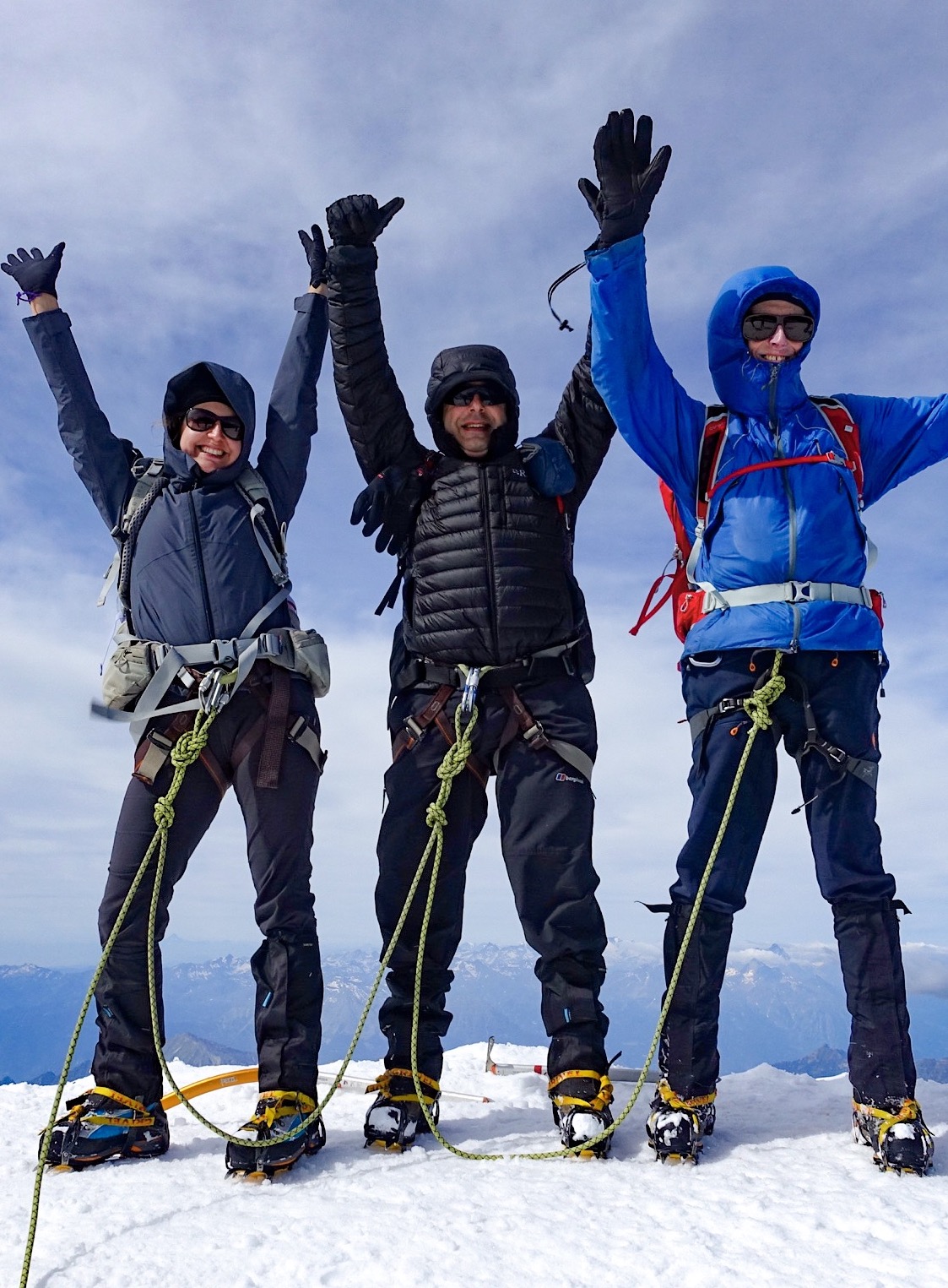
Gaiters
I almost didn’t pack my gaiters as I assumed they were just for wet British weather. However, they were an absolute must when sinking into deep snow every few steps. You don’t need long ones, a pair of short gaiters such as these would be perfect.
Waterproof/Windproof Jacket
Depending on what time of year you’re glacier hiking in the alps, there might not be much chance of rain (or snow!). We were very lucky that we made it to our mountain hut before any late afternoon storms, but there’s always a chance you’ll get caught out. Even if it’s not raining, your jacket should also be windproof which is definitely useful! There were plenty of times on this trip when I didn’t need a fleece or thick jacket, but there was a cold wind which could be kept out by my windproof/waterproof jacket. Your jacket should be lightweight and breathable – I love my Jack Wolfskin Oban Sky one.
Down Jacket
This was my favourite item! I bought it new for the trip and only wore it a couple of times as usually a windproof jacket or fleece was enough. However, every night I folded it up and used it as a pillow. Although pillows are provided in all mountain huts, I didn’t like the idea of using them (they’re not washed very often) and they’re super thin. My jacket is the Jack Wolfskin Selenium again and ever so cosy.
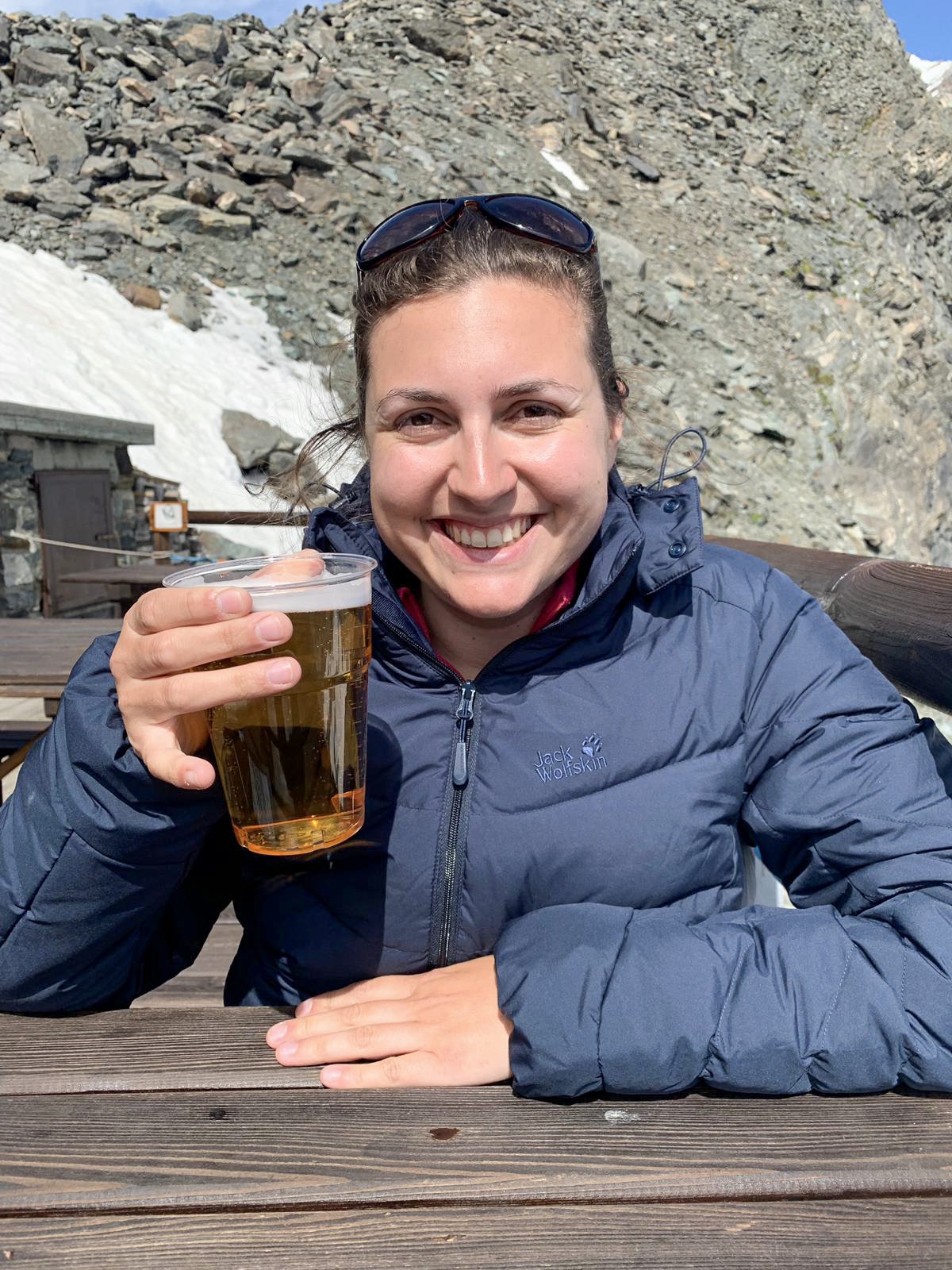
Trekking Trousers
One pair of trekking trousers. I packed two pairs of trekking trousers and two pairs of gym leggings, but our guide assured me that I would just need the one pair of trekking trousers. I was worried about them getting gross and smelly but every day when I got to the mountain hut I hung them up by the window and I survived.
Long Base Layer Top
Again just the one! Although the temptation to get a tan will be there, it’s really important to wear long sleeves on the glacier. Firstly, the UV rays are really strong and you will get burnt, especially as the sun reflects off the snow and ice. Secondly, dry glaciers are pretty abrasive so it will hurt if you fall over (which I do a lot).
T-Shirt
This isn’t a necessity, but its a nice to have on days when you aren’t on the glacier and also when you’re relaxing at a mountain hut after a day of trekking. I packed a really lightweight gym top for maximum tan, minimum weight.
Thermal Leggings
Again not a total necessity, but it can get cold at 4000m so these are great to wear under your trekking trousers at higher altitude. I only wore mine once, but they doubled up as pyjama bottoms so a good packing item all in all.
Fleece
One (fairly thin) fleece was perfect for wearing as a middle layer between my base layer and my jacket on colder days, and wearing in the mountain huts in the evening. I took my bright pink one because, well, I like pink!
Underwear
Most people I spoke to up in the mountains packed a spare pair of pants that they would change half way through the trip. Personally, there was no way I was packing any less than one pair of knickers per day… intimate hygiene is extremely important to me! I don’t care about carrying an extra few grams of weight in my rucksack if it means staying fresh down there. I also packed two sports bras: a more supportive one for wearing whilst trekking and a more comfortable one for sleeping in, as it’s lighter than a T-shirt.
Ski Gloves
It can get really cold at 4000m and you can’t put your hands in your pockets as you need them to hold your trekking poles or ice axe. If you fall over or purposefully sit down on the snow, you might also get wet hands which won’t dry and will just make you uncomfortable, so thick, waterproof ski gloves such as these are strongly advisable.
Thin Gloves
Sometimes it’s too hot for ski gloves but you still want to protect your hands from dry glaciers. In this case a pair of thin gloves is perfect and doesn’t take up much space in your rucksack. I didn’t bring a pair of these so had to buy an extortionately priced pair in Zermatt, but our guide recommended gardening gloves as a cheaper alternative!
Sunhat
Something else I didn’t think I would need and then had to buy in Zermatt for the price of a small horse. But actually, I’m really glad I did because the sun is really strong on the glacier and sunstroke would have ruined the trip.
Sunglasses
I wear sunglasses even on a cloudy day so I knew this was a very important item to pack. Due to the snow, you’ll need category three or four glasses and they’ll need to wrap around the side of your face. You can actually get some nice ones, I got these and wouldn’t be adverse to wearing them at home! If you’re in the market for some sports sunglasses and want to support an independent business, I’d highly recommend Eye Kit, who I’ve written about here.
Suncream & Lipsalve
It goes without saying that you need suncream and lip salves to stop you from burning on those glaciers. The reflection from the snow and ice means that the sun is essentially come at you from all directions so there’s no hiding from it. Personally I used SPF 30 on my face, SPF 15 everywhere else and an SPF 15 lip salve (although my lips still got slightly burnt).
Warm Hat or Balaclava
Obviously a hat or balaclava is essential for keeping you warm, but I have a double use for my balaclava! I’ve already mentioned that I don’t like to use the pillows in mountain huts. Combine this with earplugs that keep falling out and the perfect solution is to sleep with a balaclava on! It keeps your ear plugs in, stops your head touching the pillow and it’s nice and cosy.
Water Bottles
I read a lot of advice that said not to use a water bladder at altitude at risk of the tube freezing. I therefore packed two, one litre reusable water bottles instead. They were useful because they were easier to fill and they were thermal meaning that I could put cold water in one and hot tea in another, and they were pink so bonus there. However, it meant I could only drink when we stopped walking which I really didn’t like, and they were very heavy. Next time I’ll be taking a bladder bag with a thermal cover on the tube.

Sleeping Bag Liner
In my mountain hut survival guide I talk about why sleeping bag liners are compulsory in mountain huts. The sheets aren’t often washed, yet you don’t want to be carrying a full sleeping bag with you when trekking. Mine is cotton but silk liners are lighter.
Head Torch
Another essential item, not only will you need your head torch for midnight toilet trips, you’ll also need them for any early starts. You might be packing up your rucksack whilst others a still sleeping and, depending on your route, set off before sunrise.
Travel Towel
A few mountain huts have showers and I strongly advise that you make the most of the ones that do. In some places you can also hire a towel for an additional cost, but its advisable to pack a lightweight travel towel such as this one (obviously mine is pink).
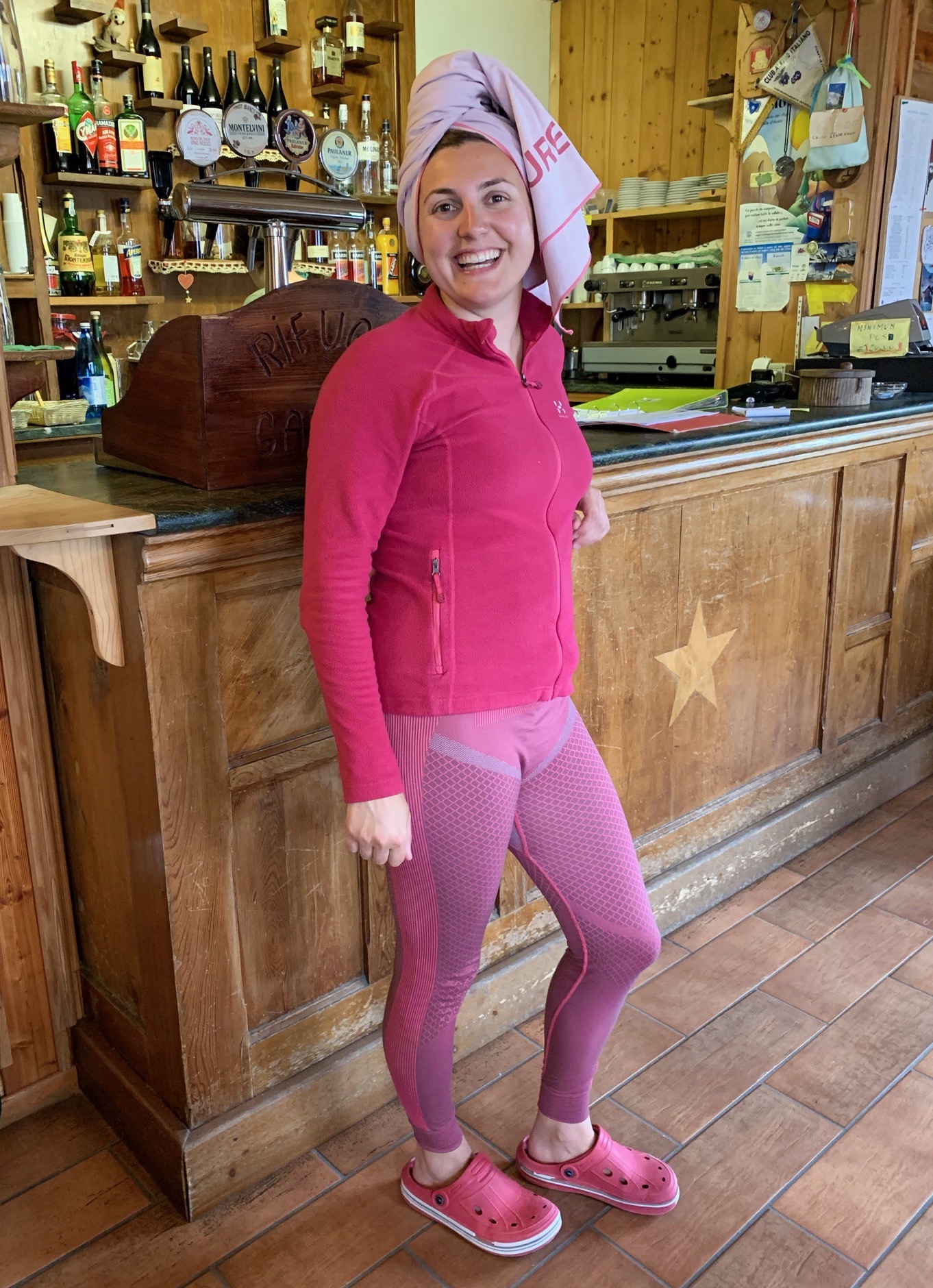
Hand Sanitiser
I sanitise my hands every time I’m about to eat on the go, but that’s just me being a germaphobe. However, I found that a lot of mountain hut toilets didn’t provide any soap so do not forget your hand sanitiser! A LOT of people use those toilets and who knows whether they’re sanitising their hands?
Baby Wipes
I’ve mentioned that some mountain huts have showers, however the majority don’t especially at higher altitude. After a day of glacier hiking you’ll want to refresh yourself at least a little, so pack baby wipes. To reduce weight, take what you need out of the packaging and transfer to a zip lock bag.
Ear Plugs
You will be sharing a room with multiple other hikers who will be snoring, talking and possibly getting ready in the morning whilst you’re still trying to sleep. If you want to ensure that you wake up refreshed in the morning then you must, must, must pack ear plugs.
Luxury Item
I cheated here and took more than one luxury item (shhh!). One of these was my kindle, which was great when I couldn’t sleep at the 9pm bedtime that everyone adopted and also for relaxing in the sunshine when we arrived at mountain huts in the early afternoon. My other luxury item was my night cream. I used suncream instead of moisturiser in the mornings, but after cleansing my face with those useful baby wipes (not something I would do at home!) I couldn’t live without my night cream.
If you would like any advice on hiking kit essentials please do get in touch! And if you’d like to read more about hiking, you might enjoy the following posts:
- Mountain Huts: What to Expect and How to Survive
- A Slightly Girlie Guide to Hiking Kit Essentials
- 10 Things I Learnt on the Spaghetti Tour
- A Guide to Planning, Booking and Walking the West Highland Way
- Mont Blanc to the Matterhorn
- What to Expect on the GR20
- Crib Goch and Snowdon
Nell xx




Wow how exciting! It’s great to read a different type of blog like this.